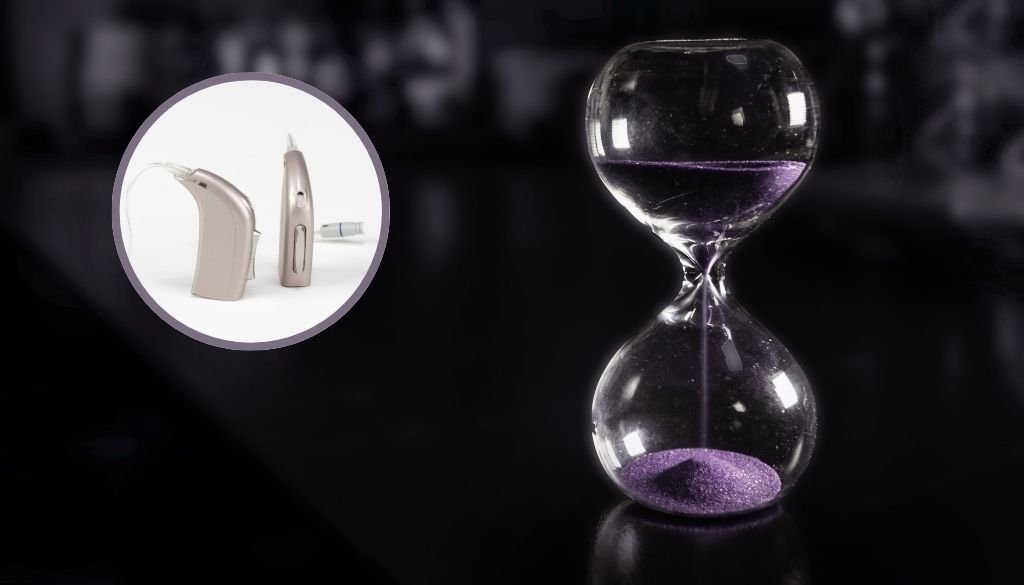The 5 minute rule for hearing aid batteries is a simple yet crucial practice that can greatly impact the performance and longevity of your hearing aids. By understanding and following this rule, you can ensure that your batteries are fully charged and ready to provide optimal power for your hearing aid.
When you purchase a new battery, it is important to wait for about one minute after removing the sticker before inserting it into your hearing aid. This allows air to flow into the battery, activating it and providing a full charge. Additionally, it is recommended to leave the battery compartment door open at night to maximize battery life when the hearing aid is not in use.

When testing your batteries, it is important to do so at night when they have not been in use for several hours. This will give you a more accurate power reading, as batteries may show a ‘good’ reading in the morning after not being used overnight.
Proper disposal of old batteries is essential for safety and environmental reasons. Be sure to keep spare batteries out of reach of children, as they can be harmful if swallowed. By following these guidelines, you can ensure a seamless experience with your hearing aid and prolong the life of your batteries.
Key Takeaways:
- Wait for about one minute after removing the sticker before inserting a new battery into your hearing aid.
- Leave the battery compartment door open at night to maximize battery life.
- Test your batteries at night when they have not been in use for several hours for accurate power readings.
- Properly dispose of old batteries and keep spare batteries out of reach of children.
- Following these guidelines can enhance the performance and longevity of your hearing aids.
How to Change Hearing Aid Batteries
Changing the batteries in your hearing aid is a simple process that can be done in a few easy steps. Follow these instructions to ensure a smooth battery replacement:
- Locate the battery compartment on the bottom of your hearing aid. It is usually marked with a small door or a tab that can be easily opened.
- Swing open the battery compartment door to access the old battery. Carefully remove the old battery and dispose of it properly.
- Take a new battery, making sure to remove the sticker on the back. It is important to note that different battery sizes are associated with different colors.
- Please insert the new battery into the battery compartment, ensuring that it is facing in the correct direction. The positive and negative ends of the battery should align with the markings in the compartment.
- Close the battery compartment door securely. If your hearing aid has a tamper-resistant battery compartment, make sure it is fully locked.
Remember to follow proper safety precautions when handling hearing aid batteries. Keep them out of reach of children, and never attempt to swallow or inhale them, as they can be harmful.
By following these steps, you can easily change the batteries in your hearing aid and ensure that it continues to function optimally.
Battery Maintenance Tips and Battery Sizes
Proper battery maintenance is essential for optimal performance and longevity of your hearing aid. Here are some important tips to keep in mind:
- Always have spare batteries: It’s a good idea to keep extra batteries on hand so you don’t have to worry about running out at an inconvenient time. Make sure to store them in a cool, dry place away from direct sunlight.
- Replace batteries when low: As soon as you notice a decrease in your hearing aid’s performance or if you hear a beeping sound, it’s time to replace the batteries. Please don’t wait until they completely run out of power, as this can lead to a sudden loss of sound amplification.
- Please choose the right battery size: Most hearing aids use size 312 batteries, but it’s important to check the user manual or consult with your audiologist to confirm the correct size for your specific model. Using the wrong battery size can lead to poor performance or even damage to your hearing aid.
- Remove the sticker and wait: Before inserting a new battery, remove the sticker and wait for about two minutes. This allows air to flow into the storm and activate it fully. Skipping this step may result in reduced battery life and performance.
Remember, to ensure a proper fit, always insert the battery in the right direction and close the battery compartment securely. If you find it difficult to close the battery door, double-check the battery’s direction and try again.
Proper Battery Sizes for Hearing Aids
Hearing aid batteries come in different sizes, each associated with a specific color. The most common sizes are:
- Size 10 (Yellow): The smallest size suitable for smaller hearing aids.
- Size 312 (Brown): The most commonly used size for behind-the-ear (BTE) and in-the-ear (ITE) hearing aids.
- Size 13 (Orange): Larger batteries primarily used for high-power BTE hearing aids.
- Size 675 (Blue): The largest size designed for power-hungry BTE and cochlear implant devices.
It’s important to note that the battery size you need depends on the specific make and model of your hearing aid. Consult your hearing healthcare professional or refer to the user manual for accurate information regarding the correct battery size.
By following these battery maintenance tips and using the appropriate battery size, you can ensure optimal performance and longevity of your hearing aid. Remember to handle batteries with care, dispose of them properly, and seek professional help if you have any concerns or questions about your hearing aid’s battery.
Maximizing Battery Life and Battery Safety
When it comes to hearing aid batteries, maximizing their lifespan is essential for uninterrupted hearing assistance. By following a few simple tips, you can ensure that your batteries last as long as possible, saving you time and money. Here are some strategies to help you maximize battery life:
- Keep the battery compartment door open at night: When you’re not using your hearing aid, leaving the battery compartment door open allows the battery to conserve power. This can significantly extend the battery’s lifespan.
- Use battery testers: Testing your batteries at night, after they haven’t been in use for several hours, gives you a more accurate reading of their power level. This can help you prevent sudden power failures and allow you to plan.
- Dispose of old batteries properly: Properly disposing of old batteries is crucial for both environmental and safety reasons. Consult your local waste management guidelines for the correct way to dispose of hearing aid batteries.
- Keep batteries out of reach of children: Batteries, especially button batteries, can be extremely dangerous if swallowed or inhaled by children. Always store spare batteries in a safe place, out of reach of little ones.
While maximizing battery life is important, it’s equally crucial to prioritize battery safety. Here are some essential tips to keep in mind:
- Handle batteries with care: When changing batteries, make sure to handle them properly. Avoid touching the metal contacts to prevent dirt or oil transfer, which can affect battery performance.
- Avoid exposing batteries to moisture: Moisture can damage hearing aid batteries. Keep them away from water or excessive humidity to ensure optimal performance.
- Seek immediate medical attention for swallowed batteries: If a battery is accidentally ingested or inhaled, it’s essential to seek close medical attention. Swallowed batteries can cause serious harm and should be treated as an emergency.
Conclusion
In conclusion, the 5 minute rule for hearing aid batteries is a simple yet important practice to ensure optimal performance and longevity of your hearing aids. By following this rule, you allow air to flow into the battery, providing a full charge and enhancing battery life.
Properly changing hearing aid batteries is crucial. Remember to locate the battery compartment, discard the old battery, and insert a new one with the sticker removed. Always ensure the battery is facing the correct direction and securely close the battery compartment door.
Battery maintenance is key to prolonging the life of your hearing aid batteries. Keep spare batteries on hand, replace them when low, and clean the battery compartment regularly. Additionally, maximizing battery life can be achieved by keeping the battery compartment door open at night when the hearing aids are not in use.
Lastly, prioritizing battery safety is vital. Dispose of old batteries properly and keep them out of reach of children. Swallowed batteries can be extremely dangerous, so seek immediate medical attention if any accidents occur.
Frequently Asked Questions
What is the 5 minute rule for hearing aid batteries?
The 5 minute rule refers to the practice of waiting for about one minute after removing the sticker from a new battery before inserting it into the hearing aid. This allows air to flow into the storm and provide a full charge.
How do I change hearing aid batteries?
To change hearing aid batteries:
- Locate the battery compartment on the bottom of the hearing aid.
- Swing open the battery compartment door, discard the old battery, and insert a new battery with the sticker removed.
- Make sure the battery is facing in the right direction and close the battery compartment door securely.
How should I maximize battery life and ensure battery safety?
To maximize battery life, it is recommended to keep the battery compartment door open at night when the hearing aid is not in use. Additionally, use battery testers at night when the batteries have not been in use for several hours to get an accurate power reading. Properly dispose of old batteries and keep spare batteries out of the reach of children to ensure safety.
What are the recommended battery maintenance tips?
It is important to have spare batteries on hand and to replace the battery when it is low. Clean the battery compartment regularly and avoid getting the hearing aid wet. When handling hearing aid batteries, follow proper safety precautions to prevent accidents.



